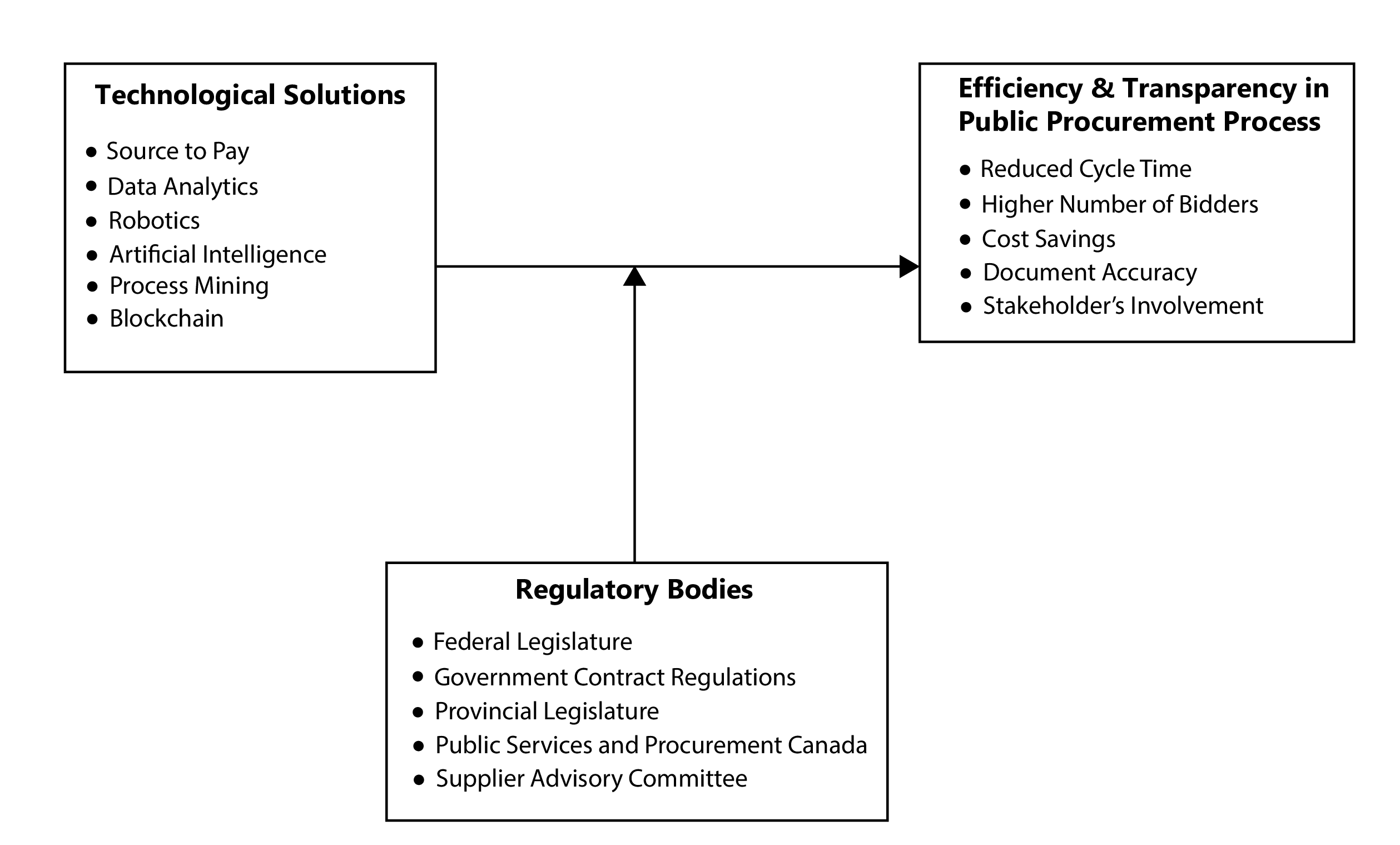7.1: Technology in Public Procurement

In recent years, the global landscape of public procurement has witnessed a significant transformation with the widespread adoption of technology. Countries worldwide have increasingly embraced digital solutions to enhance the efficiency and transparency of their public procurement processes. Utilizing technologies such as procurement systems, blockchain, and artificial intelligence can revolutionize traditional procurement methods, providing governments with tools to streamline operations, mitigate risks, and foster greater accountability.
Public sector organizations worldwide are experiencing an unprecedented pace of change. As a result, they are rapidly re-evaluating their operating models and market strategies not just to withstand these market forces but also to capitalize on them. Procurement has a significant role in helping the public sector achieve its objectives and prepare for the uncertainty ahead. This will require procurement to focus on driving costs down. However, the opportunity also exists for the function to add value in a much more strategic way (Leenders et al., 2008).
Procurement has the potential to significantly impact national economies as well as the competitive position of individual organizations. Oyuke and Shale (2014) state that organizations must maximize the use of procurement in every aspect of the business, linking across all members of the supply chain, increasing the speed of information transfer, and reducing non-value-adding tasks.
As the procurement role embraces technological advancements, particularly in e-procurement systems, there has been a noticeable enhancement in the efficiency of procurement processes. Automated systems have streamlined workflows, reduced manual errors and accelerated the procurement lifecycle. Additionally, technology has played a pivotal role in enhancing transparency by providing real-time access to procurement information, fostering accountability and mitigating corruption risks. This shift toward digital solutions improves the overall effectiveness of public procurement and establishes a more accountable and transparent framework for government expenditures.
Conceptual Framework
The conceptual framework diagram illustrates the intricate relationship between technology adoption and its impact on efficiency and transparency in public procurement processes. It visually depicts how the integration of advanced technologies, such as e-procurement and supply chain management systems, influences the various stages of procurement. Exhibit 7.1 explains the interplay between technology implementation, procedural efficiency, and the enhancement of transparency within the public procurement domain, providing a holistic view for policymakers, researchers, and stakeholders seeking to navigate the evolving landscape of technological advancements in government procurement.

Technological Solutions in E-Procurement Systems
Technology plays a pivotal role in transforming public procurement processes, offering significant benefits in efficiency, transparency, and accountability. Adopting e-procurement systems is crucial for streamlining procurement operations and reducing inefficiencies. Moreover, through e-procurement platforms, technology contributes to transparency in the procurement process. Real-time access to procurement data ensures visibility, accountability, and fair competition among suppliers (Ombui & Waema, 2018). The transparency brought about by technology helps mitigate corruption risks and promotes a level playing field for businesses seeking government contracts. Implementing technology in public procurement is crucial for achieving the public procurement processes, supporting the government’s goal of enhancing governance and integrity in procurement processes.
Regulatory Bodies in Public Procurement
Public Services and Procurement Canada (PSPC) supports federal departments and agencies in their daily operations as their central purchasing agent. The Treasury Board of Canada establishes and maintains the regulatory framework for public procurement, ensuring fair and transparent processes. Public Service and Procurement Canada (PSPC) uses Infosys Public Services to support and integrate technology into procurement processes, including the implementation of electronic procurement systems to enhance efficiency. Meanwhile, the Office of the Information Commissioner of Canada oversees the implementation of the Access to Information Act. If someone feels that their request for information related to public purchasing has not been handled correctly, they can file a complaint with the OIC.
Efficiency and Transparency in Public Procurement Processes
Public procurement processes play a pivotal role in government expenditure and resource allocation. The adoption of technology, particularly e-procurement systems, has been instrumental in enhancing the efficiency and transparency of these processes. Studies indicate that e-procurement contributes to streamlined workflows, reducing procurement cycle times and associated costs (Carter & Narasimhan, 2018). Moreover, the digitization of procurement activities enhances transparency by providing real-time access to procurement data, ensuring accountability and minimizing corruption risks (Choudhury & Sabherwal, 2018). As governments globally seek to optimize resource utilization and foster fair competition among suppliers, integrating e-procurement technologies is a crucial mechanism for achieving efficiency and transparency in public procurement (Hsu & Lee, 2019).
Efficiency Gains
Implementing e-procurement systems has significantly reduced the time required for each stage of the procurement lifecycle. Automated processes, such as e-sourcing and e-auctions, have expedited decision-making processes, contributing to a more agile and responsive procurement environment.
Transparency Enhancements
Technology adoption in public procurement enhances transparency. The introduction of digital platforms and the migration to online documentation have made procurement information more accessible to stakeholders. Suppliers, citizens, and oversight bodies now have unprecedented access to procurement data, fostering a culture of openness and accountability. While technology has undoubtedly improved transparency, challenges remain concerning data security and integrity. Cybersecurity breaches threaten the confidentiality of sensitive procurement information. Thus, procurement entities must invest in robust cybersecurity measures to mitigate risks and uphold the trustworthiness of digital procurement platforms.
Challenges in Technology Adoption
Resistance to change remains a challenge. Accustomed to traditional methods, procurement professionals are hesitant to embrace technological innovations. Overcoming the resistance requires comprehensive change management strategies that address fears and misconceptions and provide adequate training and support.
Infrastructure limitations also pose a challenge to widespread technology adoption. In some regions, inadequate internet connectivity and outdated hardware hinder the seamless integration of digital systems. Addressing infrastructural gaps is crucial for ensuring equitable access to the benefits of technology across the public sector.
Practical Procurement: Scenarios and Solutions
Gurleen Mann, the newly appointed Director of Procurement at the City of Riverton, faced a significant challenge. Tasked with modernizing the city’s procurement processes, Gurleen was aware that the current system was outdated and inefficient, leading to delays and increased costs. This inefficiency was a financial burden and affected the city’s ability to provide timely services to its residents. Gurleen knew that improving the procurement function was crucial for enhancing the overall effectiveness of the city’s administration.
The City of Riverton, with a population of 500,000, provided a wide range of public services, including waste management, public transportation, and infrastructure maintenance. The city’s procurement department was responsible for acquiring goods and services necessary for these operations. With a team of 50 employees, the department managed an annual budget of $200 million. The city’s revenue came from taxes, federal grants, and service fees. However, the procurement process was plagued by manual procedures, lack of transparency, and frequent delays, often leading to public dissatisfaction and scrutiny.
Gurleen considered several options to address the procurement issues. The first option was to implement an e-procurement system. This technology would digitize the procurement process, making it more efficient and transparent. Providing real-time access to procurement data would ensure accountability and reduce the risk of corruption. Studies had shown that e-procurement could significantly reduce procurement cycle times and associated costs.
The second option was to conduct comprehensive training for the procurement staff. This training would focus on best practices in procurement, including ethical standards, negotiation skills, and the use of technology. By enhancing the skills and knowledge of the staff, Gurleen believed that the department could operate more effectively and efficiently.
The third option was to establish a centralized procurement office. This office would oversee all procurement activities across the city’s various departments, ensuring consistency and compliance with procurement policies. Centralization could lead to better coordination, bulk purchasing benefits, and improved supplier relationships.
Gurleen needed to decide which option, or combination of options, would best address the procurement challenges. The decision was critical as it would impact the city’s financial health and its ability to serve its residents effectively. Gurleen was aware that any delay in addressing these issues could lead to further inefficiencies and public dissatisfaction.
Discussion Questions:
- How can the implementation of an e-procurement system improve the efficiency and transparency of the City of Riverton’s procurement process?
- What are the potential benefits and challenges of conducting comprehensive training for the procurement staff?
- How could establishing a centralized procurement office strengthen the effectiveness of the procurement function in the public sector?
Source: Scenario and questions created with the assistance of Microsoft Copilot.
Checkpoint 7.1
Image Description
Exhibit 7.1: The image is a structured diagram categorizing various types of risks related to business or supply chain management. It divides risks into three main categories: External Risks, Distribution Channel Risks, and Internal Risks. Each category is presented within a framed box. The External Risks box lists factors such as natural, geopolitical, government, consumer preferences, economic, competitors, cyber attacks, changes in environment, technological, market failures, social, commercial, regulatory climate, ecological, and legislation. The Distribution Channel Risks box includes loss of merchandise, labour unavailability, information accuracy, cargo damage, disasters, infrastructure unavailability, quality of insurance risks, outsourcing risks, partnership risks, and supplier performance risk. The Internal Risks box identifies privacy, security, supply network, forecasting accuracy, reputation, corporate controls, employees, operations and production, legal, non-performance, management and procurement, human error, technical, non-technical, and deficient knowledge. Below these boxes, arrows point towards four business aspects: Value Adding Activities, Supply Chain Stages, Supporting Environment, and End Market, indicating the areas impacted by these risks.
Attributions
“7.1 Technology in Public Procurement” is adapted from “The Impact of Technology Adoption on Efficiency and Transparency in Public Procurement Processes in Kenya” copyright © 2024 by Nebert Ombajo Mandala, Ayoyi Isaac Renson and Too Samson Kipteker, European Scientific Journal, European Scientific Institute, licensed under a Creative Commons Attribution 4.0 International License, except where otherwise noted.
Exhibit 7.1 is adapted from Figure 1.1: Conceptual Framework from “The Impact of Technology Adoption on Efficiency and Transparency in Public Procurement Processes in Kenya” copyright © 2024 by Nebert Ombajo Mandala, Ayoyi Isaac Renson and Too Samson Kipteker, European Scientific Journal, European Scientific Institute, licensed under a Creative Commons Attribution 4.0 International License, except where otherwise noted. This rendition copyright © 2024 Conestoga College, CC BY-NC-SA 4.0.
“Practical Procurement: Scenarios and Solutions” box was created with the assistance of Microsoft Copilot and is shared under the Creative Commons – CC0 1.0 Universal License.
The multiple choice questions in the Checkpoint boxes were created using the output from the Arizona State University Question Generator tool and are shared under the Creative Commons – CC0 1.0 Universal License.
Image descriptions and alt text for the exhibits were created using the Arizona State University Image Accessibility Creator and are shared under the Creative Commons – CC0 1.0 Universal License.
Systems that allow for purchasing and selling supplies, equipment, works, and services through a web interface or other networked system instead of paper-based processes.

